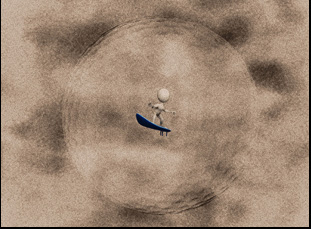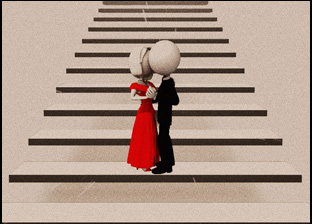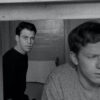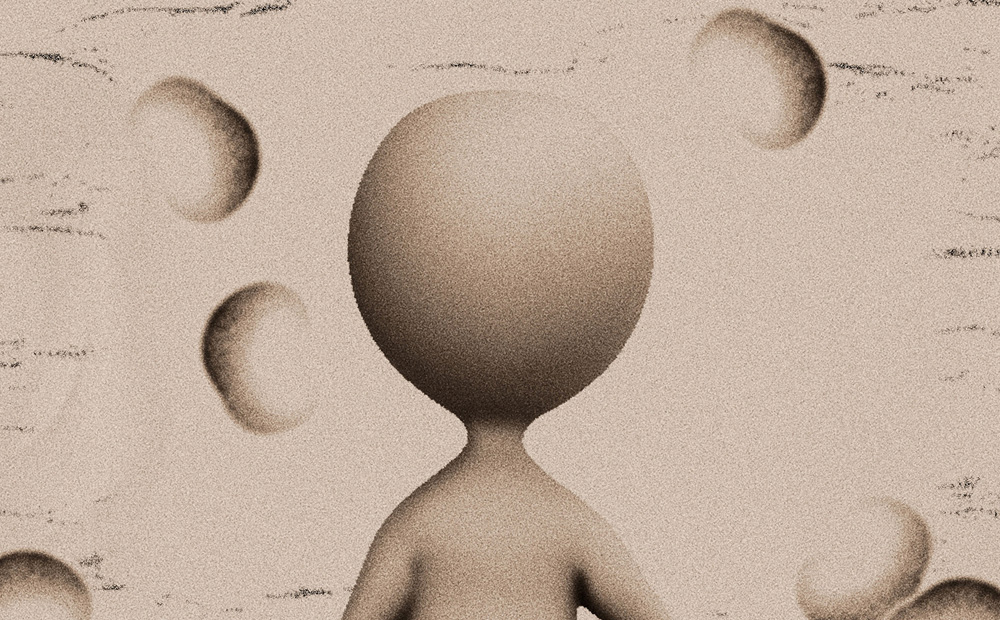It’s the things that you don’t go looking for that can be the most rewarding in “Paradise Man (ii),” Jordan Michael Blake’s absorbing short, a story that unfolded in behind the scenes as much as in front of it when the filmmaker scoured the internet for random imagery to begin building the story of a faceless figurine that sets out with the goal of hitting a hole in one. Blake didn’t need to look up too many golfing GIFs when his hero spends less time on the links than inside the recesses of his own mind, probing why such a goal is important to him, and shrewdly the tale led the director to corral the collective consciousness of the World Wide Web where distractions can occasionally provide enlightenment more than what you go seeking in the first place.
“Welcome to this random place,” Paradise Man says gregariously, ushered in on a cloud at the start of the 12-minute adventure into the subconscious, but Blake stumbles upon something profound as the seemingly carefree character has to pause his pursuit of the hole-in-one and all his fantasizing about it to come care for his mother who is rendered speechless by injuries from a car accident. If what’s actually important becomes clear to the protagonist, it emerges from clutter that will be familiar to audiences, repurposed visual ephemera that comes alive when Blake puts it into motion but typically exists as the wallpaper en route to somewhere else. And when the digital artifacts around the imagery and inherent to a small degree in Paradise Man’s otherwise avuncular voice make themselves known, it can feel as if wading through a landscape now ruled by technology to get back in touch with humanity is a crucial part of an epic quest that seems so benign from the outset.
With the film making its premiere this week at the Sundance Film Festival as part of the Animated Shorts Program, Blake spoke about how he ended up creating this engaging and unexpected search for the meaning of life, allowing the materials he had tell him what story he could tell and offering an explanation to that stranger who saw him dancing on the street that one day this past fall why he was so happy.

A lot of it’s the pandemic. I couldn’t shoot anything. I also became part of this thing called Racer Trash, this pandemic phenomenon thing where a bunch of people that work as editors got together and started re-editing feature films in a vaporwave aesthetic. It was really crazy and I started using the skills that I have as an editor to create things that were completely new. I followed that progression into animation, which I’ve always loved. I just don’t know how to draw. So this movie was made repurposing stock animations. I basically found this random Christian PowerPoint website and I wanted to just tell a story through the stock footage that was there.
This does share a principal character with “Delta Airline Saftey Video.” How did it make its way into this?
I basically just started using that guy for memes and text chats with my friends and I made “Delta” with with the guy just because it was a stock image. Then I realized that there were GIFs of the guy, like pointing to something over and over again and I started thinking, “Maybe I can tie all of these together and make him the main character of an actual movie.” I did “Delta” for Taco Bell Film Festival, this spoof festival that I run, and it was so much fun that I thought maybe if I work a little longer and harder I can actually make a real movie out of this.
Did you actually have much of an idea for a story before digging into the images? It seems like an interesting process, particularly as an editor to be limited to footage you didn’t create yourself intentionally.
Basically I had the internet at my disposal instead of footage, so something that didn’t make it into the movie is that he would hit a golf ball into a lake and then we would go into the water, but then I would look up water imagery and see what stock images there were for water and work on that. When it doesn’t work, I’d think, “Okay, well, I guess I’ll just do a different idea.”
The first thing that I found and liked was that first shot of the golf ball getting hit off the tee and I had set it to a piece of music. Something about that combination with the character was exciting, so the golf [idea] came from the stock image and the rest of the story, I knew I was trying to tell a story about a mother and her son.
There’s a literal depth, as much as there is an emotional one, to the images which pile on top of each other. Was it interesting to think about that kind of dimensionality with the images?
It’s fun because I work as an editor and this doesn’t have that many cuts in it. I wanted to hypnotize or create something that I could maybe fall asleep to originally, so the idea of just constantly moving inward [was there]. There’s also probably a bit of a drug influence there when coming out of the pandemic, I had a drug phase, so it replicates a little bit of the idea of like going deeper and deeper into your mind.
What was it like to find the voice? It’s familiar in sounding like a traditional British narrator, but has a certain digital accent to it.
I just wanted to make a whole movie with my laptop, so there’s no voice actors, but also I was scared of AI and this doesn’t use AI. But I wanted to see if I could tell a story with a character that doesn’t have a face and still get you to feel things about it. That felt like the most fun challenge of the movie and then the digital nature of it goes hand in hand with [the idea of] can you relate to something if it’s not really a person?

That was the foundation of the whole movie, and even in some of my earlier live-action movies, I was always trying to figure out how to make something look like a Polaroid. It led this project into making something feel like it was on a newspaper that felt like a way to make that digital world a little bit more comforting. One of my favorite Miyazaki things is that he likes animation because it’s inherently a comforting space to be in and whether or not that’s exactly true, it’s definitely something [that inspired me to create a] nice liminal space for you to be in for 12 minutes.
Was there anything that happened along the way that changed your ideas of what this could be or maybe took it in a direction you didn’t expect?
I made the movie in two months, so it was just like “get up and go,” but when I made the first minute-and-a-half of the movie, not knowing if anybody could hang with it, and I screened it for some friends and asked them how long would you be able to watch this. I got some feedback and from there, I pretty much just went for it. But I wrote the movie as I was animating it and everything was changing direction the whole time. That’s another thing that I like that Miyazaki does is that he knows where he’s trying to get to but he doesn’t write a script. So there was no script for this movie. Sometimes I would animate a whole sequence and decide it just wasn’t very good, so I would just hit delete and go a different direction.
What was it like finding out you got into Sundance?
It was crazy. I was laughing a lot. I finished the movie at an odd time and was a little bit doing the festival calendar backwards, so I didn’t apply to that many festivals, just a few major ones and this was the last chance that I had for the movie to play a big, big festival. I felt like I was about to move on, so getting in was was pretty strange. And at first, I didn’t believe them. I had to remember when the phone call ended that they had said “Paradise Man.” After the phone call ended, I was like, “Oh, man, what if I got the call for somebody else’s movie?” But it was a blast. I danced in the street when I got out of my car and this one guy who had no idea why I was dancing gave me a thumbs up.
“Paradise Man” will screen at the Sundance Film Festival as part of the Animated Short Film Program on January 24th at 8:30 pm at the Library Center Theatre, January 25th at 5:20 pm at the Megaplex Redstone, January 27th at 10 pm at the Broadway Centre Cinemas in Salt Lake City and February 1st at 5:20 pm at the Megaplex Redstone. It will also be available online from January 30th through February 2nd via the Sundance virtual platform.




